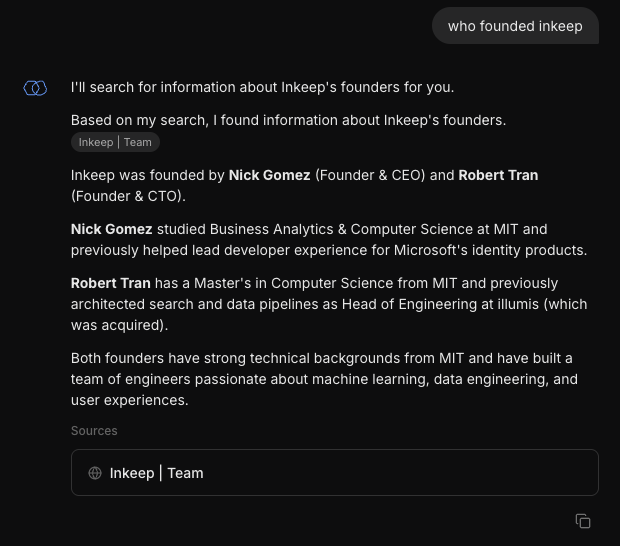Artifact Components
Copy page
Artifact components are used to add artifacts to the Agent.
Artifacts are structured components that capture and store source information when agents interact with tools or other agents. They act as a record-keeping system, automatically documenting where information comes from during tool and agent interactions.
How Artifacts Work
When an agent uses a tool (whether that's another agent or a utility tool), the response is automatically parsed to create artifacts. These artifacts store:
- The source of the information (tool/agent used)
- The relevant content from the response
- Metadata about the interaction
Quick Start: Citation artifacts are automatically included when you create
a new project with npx @inkeep/create-agents. You'll find the complete
implementation in artifact-components/citation.ts in your project. They
provide a ready-to-use example for source attribution (for example, when
citing webpages) and are automatically rendered by the Inkeep widget with
professional styling and interactions.
How to create an artifact component
- Go to the Artifact Components tab in the left sidebar. Then select "New artifact component".
- Add in an id, name, and description. These are required fields.
- For the props schema, you can either:
- Enter a JSON schema with
inPreview: trueproperties to define specific fields that will be immediately available - Leave empty to save the entire tool result without filtering
- Enter a JSON schema with
- Click "Submit".
To visually add the artifact component to the Agent, see the Sub Agents page for details.
Schema Requirements
Critical: Your artifact schema must match your tool's output structure. The system uses JMESPath selectors on JSON - it cannot extract from free text.
Use OpenTelemetry traces to debug schema validation issues.
Preview Fields
Set inPreview: true on properties for immediate availability. These fields are:
- Shown to other agents for reasoning
- Streamed in real-time to clients (Vercel AI SDK)
- Auto-rendered by Inkeep's widget (citations as interactive cards)
- Available immediately in UI (full artifact loads on-demand)
For more details on how artifact data is streamed via the API, see Data Artifact Events.
Example:
Citation artifacts that are named citation and have title and url preview fields are auto-rendered by Inkeep's widget in two ways:
- Inline footnotes: Numbered references [1], [2], etc. appear inline with the response text
- Interactive cards: Source cards with title, URL, and content appear below the response for detailed exploration
Important: The artifact must have a name of citation in order to be
auto-rendered by Inkeep's widget.

Artifact Name & Description Generation
Important: Artifact names and descriptions are automatically generated at the agent level using that specific agent's configured summarizer model.
How It Works
When an agent creates an artifact during tool execution or data processing:
- Agent Creates Artifact: During tool execution or data processing
- Summarizer Analysis: The agent's summarizer model analyzes:
- The artifact content and structure
- Recent conversation context
- The user's original question or request
- Name Generation: Creates a concise, descriptive name (max 50 characters)
- Description Generation: Provides context about relevance and content (max 150 characters)
Model Settings for Artifacts
Each agent uses its configured summarizer model for artifact generation:
Inheritance and Fallback
Artifact generation follows the same model inheritance rules:
- Default: Sub Agent uses the Agent's summarizer model (if configured)
- Fallback: If no summarizer configured at project/agent level, falls back to Sub Agent's base model
- Override: Agent can specify its own summarizer model
Best Practices
- Consistent Models: Use the same summarizer model across related agents for consistent artifact naming
- Appropriate Models: Choose models good at summarization (GPT-4o-mini, claude-3.5-haiku work well)
- Temperature Settings: Lower temperatures (0.1-0.3) provide more consistent naming patterns